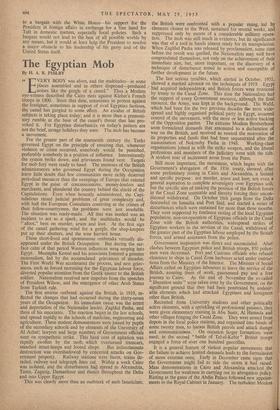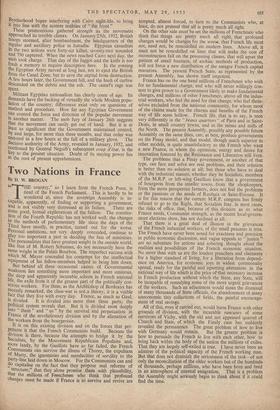The Egyptian Mob
By H. A. R. PHILBY ti VERY BODY was afoot, and the multitudes—in some places assembled and in others dispersed—produced noises like the gurgle of a camel." Thus a Moslem eye-witness described the Cairo riots against Kleber's French troops in 1800. Since that date, sometimes in protest against the foreigner, sometimes in support of rival Egyptian factions, the camel has gurgled to some effect. An exodus of British subjects is taking place today; and it is more than a premoni- tory rumble at the base of the camel's throat that has pro- voked it. For Egyptian disturbances on today's pattern are not the brief, savage holidays they were. The mob has become a movement.
For the greater part of the nineteenth century the Turks 'governed Egypt on the principle of ensuring that, whenever violence or crime occurred, somebody would be punished, preferably somebody in a position of influence. Intermittently the system brOlce down, and grievances found vent. Targets for mob fury were ready to hand. The memoirs of the British administrators who governed Egypt during the Occupation leave little doubt that few communities more richly deserved periodical massacre than the sweepings of Europe that entered Egypt in the guise of concessionaires, money-lenders and merchants, and plundered the country behind the shield of the Capitulations. Even when honestly administered, the Capi- tulations raised judicial problems of great complexity and, with half the European Consulates conniving at the crimes of their fellow-countrymen, the problems were just insoluble. The situation was ready-made. All that was needed was an incident to act as a spark, and the multitudes would be "afoot," bent on murder, arson and loot. At the first sign of the camel gathering wind for a gurgle, the shop-keepers put up their shutters, and the wise hurried home.
These short-lived and spontaneous outbreaks virtually dis- appeared under the British Occupation. But during the sur- face calm of that period Western influences were seeping into Egypt. Mustapha Kemal and his associates fostered a genuine nationalism, fed by the accumulated grievances of decades. The First World War accelerated the process, and new griev- ances, such as forced recruiting for the Egyptian labour force, diverted popular attention from the Greek usurer to the British soldier. Nationalism received new impulses from the speeches of President Wilson, and the emergence of other Arab States from Turkish rule.
The first serious outbreak against the British, in 1919, re- flected the changes that had occurred during the thirty-seven years of the Occupation. Its immediate cause was the arrest and deportation of the Nationalist leader, Zaghlul Pasha, and three of his associates. The reaction began in the law schools, and spread rapidly to the schools of medicine, engineering and agriculture. These student demonstrators were joined by pupils of the secondary schools and by elements of the University of Al Azhar; lawyers and large numbers of Government officials went on sympathetic strike. This hard core of agitation was rapidly swollen by the mob, which overturned tramcars, smashed street-lamps and looted shops. But indiscriminate destruction was overshadowed by concerted attacks on Gov- ernment property. Railway stations were burnt, trains de- railed, railway and telegraph lines cut. Within a week Cairo was isolated, and the disturbances had spread to Alexandria, Tanta, Zagazig, Damanhour and thence throughout the Delta and into Upper Egypt. This was clearly more than an outbreak of mob fanaticism; the British were confronted with a popular rising, led by elements closest to the West, sustained for several weeks, and suppressed only by means of a considerable military opera- tion. The mob was still much in evidence, but its significance was that of a tool in hands almost ready for its manipulation. When Zaghlul Pasha was released by proclamation, some time before the revolt was quelled, the Nationalists may well have congratulated themselves, not only on the achievement of their immediate aim, but, more important, on the discovery of a technique of disturbance tested in action and susceptible of further development in the future.
The last serious troubles, which started in October, 1951, showed a marked advance on the techniques of 1919. Egypt .1. had acquired independence, and British forces were restricted by treaty to the Canal Zone. This time the Nationalists had the support of every Government resource, although the final resource, the Army, was kept in the background. The Wafd, which had been for the two previous decades the most wide- spread and highly organised political party in Egypt, assumed control of the movement, with the more or less active backing of the Opposition parties. The extreme Moslem Brotherhood soon formulated demands that amounted to a declaration of war on the British, and received as reward the restoration of its properties and .funds that had been sequestrated after the assassination of Nokrashy Pasha in 1948. Working-class organisations joined in with the strike weapon, and the liberal professions and members of the judiciary went with the tide. A strident roar of incitement arose from the Press.
Still more important. the movement, which began with the Government's abrogation of the 1936 treaty, showed, after• some preliminary rioting in Cairo and Alexandria, a lithited and specific purpose : not murder, arson and loot; not even a general aspiration to complete sovereignty over Egyptian soil; but the specific aim of making the position of the British forces in the Canal Zone untenable and thereby forcing their uncon- ditional withdrawal. On October 16th gangs from the Delta descended on Ismailia and Port Said, and started a series of disturbances which were sustained for more than three months. They were supported by freelance rioting of the local Egyptian population, non-co-operation of Egyptian officials in the Canal Zone with the British authorities, widespread strikes of Egyptian workers in the services of the Canal, withdrawal of the greater part of the Egyptian labour employed by the British forces, and armed assistance from the police.
Government inspiration was direct and unconcealed. After clashes between Egyptian police and British troops, 850 police- men were decorated. Port and Customs officials who refused clearance to "ships in Canal Zone harbours acted under instruc- tions from the Ministry of the Interior. The Minister of Social Affairs called on Egyptian labourers to leave the service of the British, assuring them of work, guaranteed pay and a free journey to Cairo. At the end of November the so-called liberation units" were taken over by the Government, on the significant ground that they had been penetrated by undesir- able elements which had attacked Egyptians and foreigners other than British.
Recruited from University students and other politically active elements, with a sprinkling of professional gunmen, they were given elementary training in Abu Sueir, Al Hamada and other villages fringing the Canal Zone. They were armed from depots in the local police stations, and organised into bands of some twenty men, to harass British patrols and attack dumps and communications. On occasion larger formations were used; in the second "battle of Tel-el-Kebir " British troops engaged a force of over one hundred guerrillas.
It is a general feature of violent popular movements that the failure to achieve limited demands leads to the formulation of more extreme ones. Early in December came signs that the Government might fail to ride the storm it had raised. Mass demonstrations in Cairo and Alexandria attacked the Government for weakness in carrying out its abrogation pohcy. Rioting at the gates of the Abdin Palace followed new appoint- ments to the Royal Cabinet in January. The turbulent Moslem Brotherhood began interfering with Cairo night-life, to bring it into line with the austere realities of the front." These premonitions gathered strength as the movement approached its terrible climax. On January 25th, 1952, British troops stormed, after bombardment, the headquarters of the regular and auxiliary police in •Ismailia. Egyptian casualties in the two actions were forty-six killed, seventy-two wounded and 790 captured. When the news reached Cairo next day, the mob took charge. That day of the faggot and the knife is too fresh a memory to require description here. In the evening the Egyptian Army moved at long last, not to eject the British from the Canal Zone, but to save the capital from destruction. A few hours later, the Government fell, and the hush of curfew descended on the debris and the ash. The camel's rage was Spent.
Militant Egyptian nationalism has clearly come of age. Its demands have the backing of virtually the whole Moslem popu- lation of the country; differences exist only on questions of method and procedure. How far any Egyptian Government can control the force and direction of the popular movement IS another matter. The mob fury of January 26th suggests that the movement can easily get out of hand. But it is at least as significant that the Government maintained control, by and large, for more than three months, and that order was restored in a few hours at the fall of a military glove. The decisive authority of the Army, revealed in January, 1952, and confirmed by General Neguib's subsequent coup d'etat, is the key to the present situation. Doubt of its staying power lies at the root of present apprehensions.



































 Previous page
Previous page